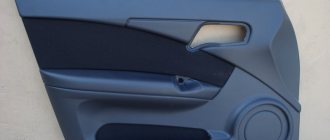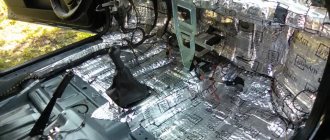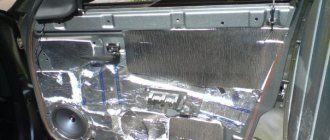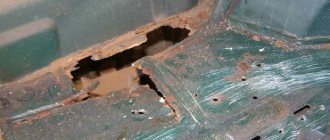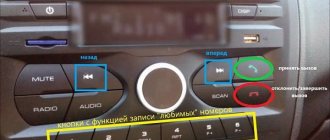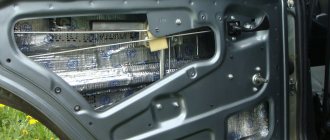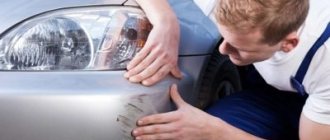The simplest and at the same time very effective way to update the appearance of a vehicle is to cover the car interior with vinyl yourself.
Vinyl film is a universal material that is ideal for the interior of any car, including premium ones. Among the main advantages of vinyl are:
Big choice
Carbon fiber, wood, chrome, films with 3D textures - among such a variety of options, you will quickly find a film to suit your taste.
Easy pasting
If you get tired of the film, changing it is not difficult. It's much faster and easier than updating your paint. Moreover, in most cases you don’t even have to dismantle the parts for gluing.
Safety
Unlike paints, vinyl film is non-toxic. This means that it is completely safe for the health of the driver and passengers.
Saving
The cost of all work on covering the interior with vinyl is several times lower than the cost of painting. And if you have sufficient knowledge and skills, you will be able to cope with the procedure yourself, which will save your finances even more.
Conditions for gluing carbon film on a car
Before gluing carbon fiber, you need to prepare a place to work, as well as a set of tools:
- Vinyl pasting is carried out at positive temperatures up to 20° C in a ventilated dry room;
- It is very difficult to work alone on tuning, so it is better to agree in advance with a partner;
- You will need scissors, a scalpel for cutting the film in hard-to-reach places, a construction knife, a tape measure and a hair dryer for drying the surface, a set of polymer spatulas for smoothing and removing air bubbles.
Avery Dennison
Avery Supreme Wrapping Film is known for its superior performance, ease of application and wide selection of colors and textures.
The materials in the Avery Supreme Wrapping Film series are particularly elastic and easily lay on the surface of the vehicle thanks to the unique Avery Easy Apply RS adhesive technology, which ensures faster and higher-quality application of the film to the surface being glued.
This technology also helps to avoid the formation of air bubbles between the material and the surface.
Matte finishes are all the rage in car wraps these days, and Avery Dennison Supreme Wrapping films are available in chic colors.
Color metallized films are also in great demand in the market.
Pink, cherry red, copper, green, silver, anthracite and matte gray have been added - now you have a great choice!
The limited time of this offer symbolizes the fact that wraps, especially in the field of personal car tuning, are very dependent on fashion.
24 new colors presented in the Avery film palette are the best reflection of current trends.
Separately, it is worth highlighting the so-called textured films - “scratched” metallic (presented in several shades) and film imitating carbon (in black and white versions). And Avery Dennison Conformable Chrome stands out completely - a silver mirror film with microchannels.
The new Avery Dennison Conformable Chrome Film offers the ability to create a shiny, mirror-like finish on any vehicle.
This film is available to both parts manufacturers and auto repair shops, as well as private car enthusiasts. Conformable Chrome film also comes standard with Easy Apply RS technology. This means that the film is easier to work with, since it can slide over the surface, and the air bubble removal system can significantly reduce working time.
The film is very convenient for covering rounded or curved surfaces of a car.
Two-layer film of various colors and structures helps to achieve an unsurpassed visual effect. Subject to operating conditions, this film will last up to 12 years!
Wet method
For those new to film wrapping, the wet method will be easier and faster.
Procedure:
- You need to cut a piece of film to the required size, taking into account a turn of 8 mm on each side. In large areas, it is allowed to leave folds up to 5-6 cm.
- The surface is degreased with a soap solution and washed with clean water.
- If there are uneven spots and scratches, then before applying the sticker you need to restore the structure of the surfaces using a primer or automotive putty. It is important to consider the following: if the primer dries in 5-7 minutes, then the putty takes up to several hours, and then it must be sanded with fine sandpaper.
- Afterwards, a soap solution is applied again - the carbon fiber will be attached to it. In order for the film to fit tightly, you must check that there are no contaminants left. And to apply the soap solution evenly, it makes sense to use a spray bottle.
- The film must be applied to the surface, having first removed the backing from it, and pressed step by step onto the paintwork, smoothing with a soft polymer spatula or felt squeegee.
- For fixation, the front part is heated with a hair dryer. The final gluing process should begin from the center of the element, gradually moving to the edges.
Important! Moisture should not be allowed to dry out during the first gluing process, so there is no need to apply the soap solution to too large an area at once.
To properly glue carbon fiber using the wet method, uniform heating must be observed, otherwise both the film and the car’s paintwork will be damaged. The minimum setting of a hair dryer in the range from +50 to +70° C is sufficient.
Pasting technology
Smart film or Smart film. Price electrochromic film
First you need to make a pattern without removing the protective layer from the film
First of all, you need to make a pattern. The process must be approached with full responsibility, as the material can easily be damaged. The vinyl film on the car is covered with a protective layer on the inside. Without removing it, we lean the vinyl against the place we are going to paste over and mark the surface with a marker. The pattern needs to be fixed using masking tape. Marks should be placed on it. They will allow you to correctly align the vinyl film when the protective film is removed.
So, how to glue film on a car? There are two ways: wet and dry. Professionals recommend the wet method as the most reliable. If so, it should be used. Before proceeding directly to pasting, you need to spray a soap solution on the paintwork, which can be prepared by diluting a little detergent in water.
It's time to remove the protective layer. It is best to do this with an assistant so that the vinyl does not touch anything and nothing gets on it. After this, you need to apply the vinyl film to the middle of the surface to be pasted and carefully glue it, smoothing it with a squeegee from the center to the edges. Haste can cause a lot of harm, so you need to work slowly. Smoothing is necessary to remove air bubbles formed under the film. Where the surface of the body bends, the vinyl is heated with a hairdryer. This is done to make the film more elastic. In places where the vinyl had to be tucked, you also need to work with a hairdryer. Sometimes it makes sense to treat the folded edges with a sealant that dries quickly.
The easiest way to apply film to a car is with an assistant.
Having covered the entire surface to be glued with vinyl, it is necessary to continuously heat this surface. This is necessary to finally get rid of minor defects and more correctly distribute the vinyl in the areas of protrusions and depressions. Heating is also necessary in order to slightly tighten the vinyl film. Naturally, it is not heat-shrinkable, but a small effect from heating is still noticeable. This completes the work process.
When the pasted surface has cooled, it should be perfectly flat. Don't worry if the first time something doesn't work out the way you would like. If desired, unsuccessfully glued vinyl can be heated again with a hairdryer and re-glued. It is more difficult to achieve excellent results on a large surface than on a small one, so it is advisable to start with small areas. If you need to cover the entire body of the car with vinyl film, then you most likely won’t be able to do everything yourself efficiently and the first time. In this case, it is better to seek the help of professionals. And if you need to stick a film, say, only on the trunk or hood, then this is quite possible for an ordinary car enthusiast. In extreme cases, this will take several attempts.
In addition to vinyl, carbon film for cars is very popular today. They look pretty good in combination with each other. The technology for gluing carbon film is the same as that of vinyl. We will be glad if the information gleaned from this article will help you successfully wrap your car.
Dry method
Dry carbon fiber pasting has its advantages:
- the film does not move during installation;
- adhesion to the paintwork of the car is higher than with the wet method;
- vinyl stretches less.
Instructions:
- Preparation for pasting using the dry method is not fundamentally different from the wet method. But after removing contaminants with a wet solution, you need to dry everything thoroughly and then treat the surface with White Spirit.
- The film is applied to the element and smoothed.
- Heat the film with a hairdryer over the entire area and gently smooth it again with a spatula.
- After careful smoothing and heating, excess carbon is cut off.
It is worth considering that 3D class carbon films are more durable than 2D and are more suitable for the dry method. High-quality films have special perforations, and these channels help to expel air evenly.
What it is
Do you think it is possible to stick carbon fiber onto parts of the interior or exterior of a car? No. Carbon is a special material with a complex structure and multicomponent composition. Individual parts and assemblies are made from it.
Therefore, when it comes to carbon film, it is important to understand that it is not carbon in its pure form. In fact, this is an imitation of a carbon surface and structure, implemented using vinyl and other materials
The film material is made based on polyvinyl chloride (PVC). At the same time, visually and to the touch it strongly resembles full-fledged carbon fiber. Due to its low cost, variety and ease of use, you can carry out an excellent modification of the car, obtaining the full appearance of natural and high-quality carbon fiber.
High-quality films are produced using the calendering method. Due to it, a thin but high-strength material is formed, which has the same thickness along its entire length.
It is the amazing visual similarity, combined with the relative ease of pasting, that makes carbon films so popular.
They can be used for various purposes and for styling various elements of the car. Namely:
- for a torpedo;
- on the bumper;
- on the hood of a car;
- on the surface of the mirror;
- interior details;
- on the roof of the car;
- on the thresholds;
- on plastic in the car interior;
- dashboard;
- glove box;
- center console, etc.
But it is not worth gluing the film on an uneven surface where there are many corners and creases. The result may disappoint you. The smoother the surface, the better the quality of the material placed on it. Therefore, it is not always possible to set straight lines at the corners, create a uniform surface without folds, etc.
Although there are craftsmen who can make high-quality carbon styling on almost any part of the body or interior of a car.
It’s also worth recalling the styling method of flocking, which I previously wrote about.
Main advantages
If you take good material and apply it correctly, there will be no talk of any shortcomings.
Therefore, in relation to good carbon films, only positive qualities can be highlighted. I would list the main advantages:
- creating a visually attractive effect;
- additional protection from dust, dirt, small stones;
- the ability to smooth out and mask defects;
- frost resistance;
- resistance to heat;
- does not fade over time;
- protects against moisture and corrosion;
- does not require complex care;
- can be applied by hand;
- If desired, it can be easily removed and changed.
The only limitation is high pressure washing at very close range. Therefore, when visiting a car wash, be sure to warn that there are parts on the body covered with carbon film.
Features of gluing with carbon-look vinyl film
Even the dry method requires drying for 4-6 hours, and a visit to a contactless car wash will have to be postponed for a couple of weeks. Otherwise, the coating will quickly come off or become covered with bubbles.
If you manage to purchase an inexpensive 2D film, then during the installation process it is better to make perforations in it yourself to remove air. For this purpose, you need to heat a thin needle and make holes in the film in a checkerboard pattern at a distance of 3-5 cm.
Using the dry and wet method, you can glue carbon film to plastic inside the car. The principle and procedure is no different from body wrapping. The difficulty lies in the geometry of the elements. In places where it is difficult to go through with a spatula, you need to roll the film with your finger to avoid uneven tension and tears.
The plastic must be cleaned of dirt and be sure to degrease before gluing the film.
After ironing with a spatula and heating with a hair dryer, it would not hurt to fix the edges of the film on the plastic with heat-resistant glue, because It can peel off when turning.
Important! Do not overheat the plastic with a hairdryer; due to high temperatures, the polymer elements can melt and deform.
Covering with corbon-look film allows you to emphasize the individuality of the car without resorting to repainting. Beginners should choose the wet method of fixing the film - it allows you to easily adjust the position of the part. Craftsmen prefer the dry method, which does not require constantly updating the layer of soap solution. The film is suitable for use both outside and inside the car. The main thing is to thoroughly clean and degrease the surface and expel all drops of air during the smoothing process. The finished tuning will last an average of 5 years.
Self-adhesive film is a good option to update furniture, walls, office equipment (laptop, phone), refrigerator and even a car without investing a lot of money. The principle of pasting is based on combining two layers: the top - wallpaper and the bottom - an analogue of adhesive tape. The advantage of using this material is undoubtedly the variety of surfaces on which it can be used: metal, wood, glass, plastic and many others. In addition, the film has a number of useful properties: moisture resistance, ease of care, ease of use, resistance to high temperatures. It is not surprising that more and more people are interested in how to glue it and where it can be used.
Advantages and disadvantages
Provided that high-quality vinyl film is used and the rules for its application are followed, the motorist will receive many more advantages than disadvantages.
The main positive points include the following:
- Due to the effect of masking defects, vinyl will hide not only scratches and chips, but even dents. Yes, they can be seen, but only from a certain angle.
- This is an effective protection against the vagaries of nature. The material resists solar radiation well, protects the body from hail, rain, various types of mechanical damage from falling branches, etc.
- Vinyl can be used to cover front and rear optics. The material is transparent, but has excellent protective properties.
- If applied correctly, the film can last 5-7 years.
- Vinyl coating is inexpensive and available to every motorist.
- The current range allows you to choose a film for every taste. There are many shades, colors, textures. One of the most popular is a film that imitates carbon coating.
There is no need to talk about any serious shortcomings.
Basically, problems arise if you use a low-quality coating or violate the application technology.
In this case, motorists face the following problems:
- the material quickly deforms and lags behind the surfaces of the car;
- under the influence of sunlight, the adhesive layer dries;
- due to the bright sun the film fades;
- the surface is characterized by roughness.
Therefore, motorists generally prefer to cover the car in the same color as the body, or use shades that are as similar as possible to the original color. If the documents indicate that the car is blue, there are many shades of this color, and in this case nothing in the documentation will have to be changed. But when the car is white and the film is black, then immediately go to the traffic police.
Scope of application
The most commonly used film is vinyl film. It is used for various purposes - in baths, kitchens, living rooms and even children's rooms. The safety of its use and beneficial properties allow you to update the design of your home, office, etc. The variety of colors will satisfy any, even the most fastidious, buyer.
A type of vinyl film is carbon-effect film. Carbon film is used to change the appearance of the car. Its versatility allows you to stick the film on the outside of the car and update the interior. On the one hand, carbon film is economical, durable, and on the other hand, it is easy to remove. Therefore, if you get tired of the color of your car, you can easily change it at low cost.
Let's look at how to properly glue vinyl and carbon film to plastic.
Purpose
Covering a car with this material has both practical and aesthetic meaning. From a functional point of view, gluing carbon film is beneficial in that it protects the car’s paintwork from the effects of external factors, such as precipitation, grains of sand and stones, ultraviolet rays, and chemically active substances. This is especially true for parts exposed to road particles, such as the hood. Externally, the coating in question quite reliably imitates carbon, as evidenced by photos and videos. Therefore, it is usually applied to those parts that are most often represented by carbon analogues, that is, the hood, mirrors, etc. The film can also be used to cover plastic in the interior. Moreover, this coating is much cheaper than the original material. You can learn about the various options for applying film both on body parts and in the interior from photos and videos. In addition, if the hood or other parts already have damage to the paintwork, they can be covered with film to hide the defects.
That is, carbon film has attractive aesthetic qualities and at the same time is strong enough to protect the car’s paintwork from various environmental factors. In addition, this material is suitable for application to various materials, such as metal or plastic, so it can be used both for coating body parts and for interior decoration.
Subject to compliance with operating rules, the service life of carbon film is up to 10 years.
Surface preparation
A properly prepared surface is the key to a long service life of the glued parts. First, the plastic must be thoroughly washed to remove dirt, dust, and debris. It is most convenient to use a soap solution made from neutral liquids for washing dishes. In this case, you need to ensure that streaks do not form. It is best to first wash with soapy water, then with water and finally wipe with a dry, lint-free cloth. After this, you need to treat the plastic with isopropyl alcohol or white spirit.
The next step is to check how smooth the surface is. If necessary, sand it, apply a primer for plastic to further ensure adhesion to the primer, treat it with a primer and sand it again. Do not neglect at least one of the listed stages. This will help make working with self-adhesive film easier.
Self-rethreading of a torpedo
Many people think that re-upholstering a car dashboard with their own hands is very simple. But in reality, if you do everything well, it is a complex process.
For example, you have to remove a torpedo, disassemble it, and then prepare the surface. If there are cracks or holes from the AirBag, you will first have to seal them with epoxy resin. Then dry for 24-48 hours. And then treat the repair areas with plastic putty and prime them. Only the preparatory stage of technology can take up to 5-7 days.
Tools
Let's look at an example of reupholstering a torpedo with self-adhesive Alcantara (luxury). You will need material as well as:
- a well-lit, warm garage, a set of tools for dismantling/installing the panel;
- sandpaper P80 - P800 (depending on the condition of the surface);
- epoxy resin or repair kit for plastic (if there are AirBag holes);
- solvent, degreaser, aerosol primer for plastic;
- air gun (construction hair dryer);
- stationery tape (for fixing the edges if you work alone), sharp scissors, a stationery knife, a plastic spatula (smooth the surface).
Aerosol primer for plastic
The garage needs space so that, in addition to the car, there is enough space to place a table for a torpedo. At the same time, nothing should interfere with your ability to walk freely around the panel while covering it.
Preparatory stage
Wipe the panel thoroughly with degreaser and let it evaporate. Sand the entire surface with P180 - P240 sandpaper. Fill defects with putty and sand the surface. Then prime the repair areas with aerosol plastic primer. Clean the panel from dust and degrease it completely. The preparations are complete.
Process technology
Covering a car panel with self-adhesive film is similar to the process of tinting windows, only without water. Step by step the work looks like this:
- Cover the panel with material.
- Start removing the backing from one side.
- Smoothly smooth the Alcantara with a spatula.
- Make cuts in the holes (air ducts or glove compartment) and insert the material into the niches.
- Alcantara stretches well, but in difficult places it is better to use a hair dryer.
- Fold the edges.
- Cut off excess material.
Panel in Alcantara VAZ 2109
The torpedo can be assembled and placed on the vehicle.
Required Tools
When working with film you will need:
- Pencil;
- Ruler or masking tape;
- A stationery or mounting knife (scissors are not advisable, there will be uneven edges);
- A rubber or felt spatula or squeegee, or a soft, lint-free cloth;
- Hairdryer, preferably industrial. For the wet method, you will need a spray bottle with soapy water.
How to glue carbon or vinyl film to plastic without bubbles
First of all, you need to carefully mark the film and try it on the desired surface. When cutting, leave a margin of 2 cm in places where the film is folded.
It is advisable to carry out this work indoors at temperatures from +8°C to +30°C. If you glue the film on the outside, there is a high probability that particles of dirt, debris, and sand will get in. This will negate all the work, since any grain of sand can lead to swelling of the film, and, as a result, you will have to re-glue it again.
These are general requirements.
There are two ways to glue film to plastic:
Dry method. More suitable for professionals. The difference from the wet method is that a soap solution is not used. As a result, it is more difficult to correct unevenness, since the film sticks faster, but in this case it also holds better.
The wet method is more suitable for beginners who have no experience working with self-adhesive film. In this case, it is recommended that two people work together. If possible, lay the film on a flat surface with the backing facing up. Carefully remove the backing. If the surface is large, then it is better to remove it gradually, starting from the top edge and smoothing from the middle to the edges. This will push the bubbles to the edges and prevent their further appearance. If the surface is small, then remove the backing completely. Spray the adhesive surface freed from paper with soapy liquid from a spray bottle (proportion 1 part liquid to 10 parts water). We turn the film over and begin gluing from the middle to the edges, smoothing it with a cloth or squeegee.
The most important thing is to correct all noticed irregularities and bubbles immediately. To do this, lift the film and re-glue it, and push out the air bubbles to the edges. If suddenly the bubble cannot be removed, do not worry, a regular needle will help you. Pierce the surface near the bubble with it, but not the bubble itself, and glue. On an uneven surface, you must first heat the film, but do not overdo it, and then carefully stretch it, achieving a perfect fit to the part without bubbles.
When finished, use a roller and then a hair dryer over the entire covered surface. Pay special attention to irregularities, bulges, and folded edges.
If you decide to glue film to a car, then now you know how to glue carbon film to plastic and more. The work is complete, but don't rush to use the car. It is recommended to leave it in a warm room for at least a day, and wash the car no earlier than after a week.
Carbon film is used mainly for pasting plastic parts of car interiors, as well as bumpers and mirrors. The difference from parts made of carbon is not noticeable, and the cost is an order of magnitude different.
As you have seen, it is not difficult to properly glue carbon or vinyl film onto plastic without bubbles. The main thing is to comply with all requirements.
For clarity, you can watch how to glue film to plastic in the video.
If you want to bring a bit of high-tech aesthetics to your car's interior, then it's time to pay attention to carbon fiber vinyl film . With its help, you can tune (see Tuning Aveo photo) and transform both small and large interior parts (center console, doors, etc.).
Application
In order to properly cover with carbon film, you need to follow the sequence of work. Do-it-yourself car wrapping with carbon film begins with preparation. It consists of cleaning the working surface and degreasing it. If there are uneven areas, you should prime them with a primer, since in this case the coating will adhere more tightly to the surface. The material must be cut into fragments for pasted body elements. They are correlated with the parts to determine cutting accuracy.
Next, the coating, without peeling off the base, is applied to the work surface and secured with masking tape. Then the base is removed, stretching the coating to prevent it from sticking. Then spray the surface with a soap solution, leaving no dry areas. After this, the material is applied to the surface and bubbles and liquid are removed from underneath it, smoothing it with squeegees: first with plastic, then with felt. Finally, the coating is heated with a hairdryer and smoothed again. Pasting rounded surfaces involves heating and smoothing the material throughout the entire work process. In any case, it is especially important to warm up critical areas of the film. Warming up allows you to more thoroughly attach the coating to the work surface, adjusting its shape. Heating efficiency is determined by temperature, so low-temperature household hair dryers are not suitable for this purpose. However, overheating is also unacceptable, as it leads to stretching of the material. Warming up is carried out gradually, treating each area. The whole process lasts 5 - 7 minutes. Finally, excess material is trimmed off with a utility knife. The free edges and joints should be treated with sealant to protect them from the mechanical influence of environmental factors. After the gluing is completed, the car is left for a day. During the week, washing can only be done using a non-contact method.
The wet method of film application is discussed above. It is widely used due to its simplicity. In addition to this technology, there is a dry method. Such work is more complex and takes more time, so usually experienced performers apply the film using this method. Application must be carried out at a temperature of at least 22°C in a dry and clean room. The main difference between the dry method and the wet method is that the material is applied to a dry work surface without using a soap solution. Otherwise, the technologies under consideration are similar, but the second is more effective.
You can cover the interior plastic with film yourself using the same methods as the hood and other body elements. The pre-glued parts are dismantled. Before you start covering the interior with carbon film, you should also watch the video.
0 0 votes
Article rating
Aveo carbon fiber trim
If you are dealing with carbon-look film for the first time, then first master the principles of working with it by gluing small parts.
For example, the linings on the front door handles in a Chevrolet Aveo quickly lose their attractive appearance, because... The silver coating on them quickly wears off from the knees. You can also use film to cover inserts on the steering wheel, plastic in the area of the handbrake, door handles, a panel with a switch for adjusting the side mirrors and the angle of low beam lamps, panels in the area of the audio system, glove compartment, etc.
Trimming the interior with carbon fiber inserts will definitely improve the interior of the Aveo.
The best materials for reupholstery
The Russian car accessories market offers an abundance of materials for reupholstering dashboards and car door panels. Here you can find modest styles with a rubber or synthetic base, which are identical to the previous coating. And there are luxurious canvases made of genuine leather. It is better to entrust working with such material to a specialist; cutting and sewing skills will be required. In any case, the car owner will have plenty to choose from. Here is a list of the most popular materials for car panel reupholstery:
- Genuine Leather;
- vinyl;
- eco leather;
- Alcantara;
- carpet;
- flock
Make your choice responsibly. After all, the front panel is visible. It says a lot about the owner of the car. About his character. About taste.
Genuine Leather
An ideal material for decorating the interior of luxury or premium cars. The fiber structure is strong. Temperature changes are absolutely indifferent to them. The surface is resistant to mechanical damage, but only if treated with care. Of course, you can scratch the skin with the same nail or other sharp object.
Covering the torpedo with leather
The material is easy to clean and retains its luxurious appearance for a long time. The sun's rays are not harmful to natural leather. To care for the surface, you will have to buy moisturizing compounds and various cleaners. If you are determined to reupholster your car's dashboard with leather, then experts recommend having it done in a specialized workshop. Then the appearance will really be chic.
Vinyl
A very interesting synthetic material. It includes:
- polymer rubber mixture;
- various resins;
- special glue;
- paints;
- plastic mass.
This is a modern tool that will allow you to qualitatively change your car's dashboard. Vinyl films can be plain or multi-colored.
Vinyl film for car interior wrapping
You can find an imitation of the coloring of animals, for example, python, leopard and others. Among others, there are materials that imitate chrome, carbon or nickel-plated metal.
The basic advantage of vinyl is its low maintenance requirements.
It is resistant to mechanical damage and retains its beautiful appearance for a long time. And most importantly, you can reupholster the car’s dashboard with your own hands.
Eco leather
Using natural leather is not always cost-effective or humane. But if you want to make the interior rich, then you can take eco-leather. This is not the leatherette that appeared in our country in the early 1990s. Now it is an advanced synthetic material without emissions of harmful substances. It is quite strong and retains a representative appearance for a long time.
Eco-leather samples
In terms of its characteristics, it is practically not inferior to natural leather. But to reupholster a car's dashboard, experts recommend looking for a professional studio. After all, it is impossible to do a beautiful job with your own hands without learning the stitching and long practice. This is the main disadvantage of eco-leather.
Alcantara
The material is better known as faux suede. Developed in the 1970s. Japanese chemist Miyoshi Okamoto. The soft velvety surface gives the car's interior a premium effect.
Alcantara does not require complex maintenance and is resistant to mechanical damage. Does not fade in the sun and is not afraid of temperature changes.
Sometimes the material is used in combination with eco-leather for a contrasting effect. The main advantage of artificial suede is that you can re-stretch the dashboard yourself.
Carpet
Non-woven synthetic material with various surface types. Often used for finishing cabinet subwoofers and interior parts. Carpet has good antistatic properties, does not fade in the sun, and is not afraid of moisture and mold. Well absorbs acoustic noise and knocks.
Automotive color carpet
It is environmentally safe, durable, does not require complex maintenance, and is inexpensive. The price depends on the structure, thickness, ductility and brand. Unanimously recognized by the owners of “nines”, “ten” and “fours”.
Flock
Velvety powder (powder). It is based on a pile made of cotton, viscose and polyamide. The material is sold in various colors. To apply the powder, a special tool is required - a flocator. The powder is sprayed onto the torpedo, previously lubricated with glue.
Suitable for processing complex panels with multiple corners and niches. Can be used for both full and partial coverage. Not suitable for torpedoes with cracks and holes from AirBag, as it repeats all surface defects.
Auto panel flocking
Before applying flock, careful preparation of the panel is required. It is almost impossible to make a high-quality suede cover yourself without experience.
Long experience required. Therefore, experts advise entrusting this type of tuning to professionals.
How to glue carbon film
As mentioned above, the process of gluing the film is simple. Tools you will need:
- Sharp knife.
- Ruler.
- Rubber spatula (called a squeegee; some people use plastic cards from mobile operator starter packs instead of spatulas).
- Construction hairdryer.
Carry out all work related to gluing the film, preferably in a dry room with a temperature in the region of 17-22 degrees C.
There are two methods of gluing carbon film: dry and wet. Taking into account the fact that the interior parts are small, it is more convenient to glue the film on them using a dry method. Therefore, we will dwell on it in more detail.
The procedure for pasting small parts of the Aveo interior using the dry method:
- Remove the part you are going to cover.
- Attach a sheet of carbon film to it and cut out the desired shape with scissors, but with a small margin (1.5-2 cm).
- Using WHITE SPIRIT, degrease the part (you can use any other degreaser).
- Remove the protective backing from the film.
- When gluing the film to the surface of the part, smooth it from the middle to the edges.
If bubbles or folds appear, carefully peel off the film and re-glue it.
- To smooth the film on bends and edges, use a hairdryer (when heated, the adhesive base on the film is activated, which will allow it to be glued more efficiently, and the film will also smooth out and tightly fit the part).
When gluing the edges of the film, it is advisable to use 3m Primer 94 (a film adhesive surface enhancer).
- At the very end, trim off the excess or long edges of the film, and then heat them with a hairdryer and glue them. Do not install parts covered with carbon fiber immediately; let the film settle for 2-3 hours.
The wet method of gluing film is more often used on large and complexly shaped surfaces. It differs from dry in the use of a water-soap solution, which allows you to adjust the film.
You can familiarize yourself with the process of gluing car parts with carbon-look film in the following videos. The guy shows and explains clearly.
How? Haven't you read it yet? Well, it's in vain...
We will be grateful for the social buttons you pressed!
Equipment
To cover a car with this material yourself, you will need the following materials and tools:
- spray,
- stationery knife,
- masking tape,
- construction hair dryer,
- rags
- squeegee made of felt and plastic,
- dishwashing detergent or soap,
- White Spirit.
Before you start covering with carbon film, you should familiarize yourself with the training photos and videos. They will allow inexperienced performers to understand how to glue carbon film. In addition, it is advisable to find an assistant, since gluing with your own hands is difficult to do alone due to the fact that the coating for large parts, such as the hood, has the appropriate dimensions.

